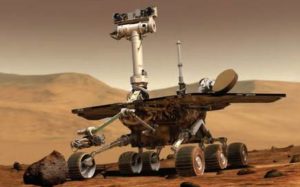NASA’s Mars Rover detects High Levels of Methane
The Curiosity Rover of National Aeronautics and Space Administration (NASA), an independent federal agency of United States has found the largest amount of methane ever measured during its mission on Red Planet (Mars).
Key Highlights
Methane Level: Although Methane has been detected by the Curiosity team many times over the course of NASA’s Mars Exploration Program but this time unusually high’ levels of methane- about 21 parts per billion units by volume (ppbv) were reported. 1 ppbv means that if we take a volume of air on Mars then 1 billionth of volume of air is methane.
Findings: Curiosity Rover’s Sample Analysis at Mars (SAM) tunable laser spectrometer came up with Methane level findings. The Sample Analysis at Mars team has also organised a different experiment to gather more information on what might be a transient plume.
Why Finding Methane is Important?
Finding such high level of methane is exciting because microbial life is an important source of methane on Earth, thus it may help scientist to look for possibility of life outside Earth.
Dilemma: The methane on Red Planet can also be created through interactions between rocks and water and since Curiosity does not have instruments that can definitively say what exactly is the source of methane, or even if it is coming from a local source within Gale Crater or elsewhere on planet, it becomes impossible to tell if methane source is either biology or geology, or whether it is even ancient or modern.
Scientists Study: Several previous research papers have documented how background levels of methane gas seem to rise and fall seasonally. They have also noted sudden spikes of methane gas, but again scientist team knows very little about how long these transient plumes last or why they are different from seasonal patterns.
Way Forward
Scientists involved in Curiosity Mission needs time to analyse these clues and conduct many more methane observations. They also need time to collaborate with other science teams such as with European Space Agency’s (ESA) Trace Gas Orbiter, which has been in its science orbit for just above 1 year.
Combining previous observations and current measurements from surface and from orbit could help scientists locate sources of gas on red planet and understand how long it lasts in Martian atmosphere.
About Curiosity Rover
It is part of NASA’s Mars Science Laboratory mission.
It is a car-sized rover designed to explore a crater on Mars called Gale.
It was launched on 26 November 2011, and landed on Aeolis Palus inside Gale crater on Mars on August 2012.
Although the planned mission lifespan for Curiosity rover once it lands on Mars is 1 Martian year (i.e. 687 days) however in December 2012 curiosity’s 2 year mission was extended indefinitely and rover is still operational as of 25 June 2019.
Month: Current Affairs - June, 2019



Aakansha Singh
June 26, 2019 at 5:49 pmNyc
Aakansha Singh
June 26, 2019 at 5:49 pmNyc